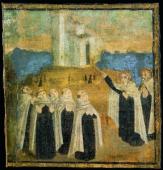“I am always thinking of you and helping you to secure Eternal Life.”
As Pope Pius XII wrote “Christ is the way; Mary reflects the way; her scapular is our keepsake on the way.”
 Saint John Paul II said in 2000: “As I look at these mountains, my thoughts turn today to Mount Carmel, praised in the Bible for its beauty. We are, in fact, celebrating the feast of Our Lady of Mount Carmel. On that mountain, located in Israel near Haifa, the holy prophet Elijah strenuously defended the integrity and purity of the chosen people’s faith in the living God. On that same mountain some hermits gathered in the 12th century after Christ and dedicated themselves to contemplation and penance. The Carmelite Order arose from their spiritual experience.
Saint John Paul II said in 2000: “As I look at these mountains, my thoughts turn today to Mount Carmel, praised in the Bible for its beauty. We are, in fact, celebrating the feast of Our Lady of Mount Carmel. On that mountain, located in Israel near Haifa, the holy prophet Elijah strenuously defended the integrity and purity of the chosen people’s faith in the living God. On that same mountain some hermits gathered in the 12th century after Christ and dedicated themselves to contemplation and penance. The Carmelite Order arose from their spiritual experience.
Walking with the Blessed Virgin, the model of complete fidelity to the Lord, we will fear no obstacles or difficulties.
Supported by her motherly intercession, like Elijah we will be able to fulfill our vocation as authentic “prophets” of the Gospel in our time… May Our Lady of Mount Carmel, whom we call upon today with special devotion, help us tirelessly climb towards the summit of the mountain of holiness; may she help us love nothing more than Christ, who reveals to the world the mystery of divine love and true human dignity.”
 I’ve been spying on what the Discalced Carmelites are doing to honor a great figure as Saint Teresa of Jesus (Avila) for the Fifth Centenary of her birth. Last evening I read a brief piece on Pope John Paul’s “Carmelite leanings” with his intense emphasis on love. The writer of the essay argued John Paul was captivated by the work and witness of Teresa and John of the Cross. In recent years I have been interested in the Carmelite approach to the spiritual life primarily because I’ve seen others radically changed by it. I have to admit, though, my soul is not Carmelite at the level of radical substance yet I am draw to what Teresa and John had to say.
I’ve been spying on what the Discalced Carmelites are doing to honor a great figure as Saint Teresa of Jesus (Avila) for the Fifth Centenary of her birth. Last evening I read a brief piece on Pope John Paul’s “Carmelite leanings” with his intense emphasis on love. The writer of the essay argued John Paul was captivated by the work and witness of Teresa and John of the Cross. In recent years I have been interested in the Carmelite approach to the spiritual life primarily because I’ve seen others radically changed by it. I have to admit, though, my soul is not Carmelite at the level of radical substance yet I am draw to what Teresa and John had to say.
The Discalced Carmelites report that in Asia interest in Teresa of Jesus and John of the Cross is increasing. A recent title at a conference reveals interest in Asia, “A dialogue between the spiritualities of Ignatius of Loyola and of John of the Cross.”
So, it is reported that hundreds of registrants in Asia are participating in courses designed to introduce inquirers of Carmelite spirituality through the eyes of two great Carmelite saints; there’s been collaboration even with the Presbyterian Church of Taiwan. Taiwan, Hong Kong, and Japan have sponsored similar Teresian courses. More work is scheduled for Israel later in 2014.
Those of us who are devoted to the spiritual maternity of Saint Teresa of Jesus (Avila) will note that her method of teaching us to pray begins by engaging in an inner dialogue with Jesus Christ, “whom we know loves us,” in an attitude of silence and listening. These days the Carmelites of the Discalced tradition are preparing themselves (and the rest of us) for the Fifth Centenary of the Birth of Saint Teresa of Jesus.
The Carmelites a working to create and disseminate songs of harmony, simplicity, and beauty, will aid in praying in the style and thought of Teresa: the point is to pray with the words and spirituality of Saint Teresa so that the persons will be led to contemplate the beauty of the Lord. Here the friars are giving “loving attention” to the role of musical harmony for prayer.
The Superior General of the Discalced Carmelites Father Saverio Cannistrà recently met the Holy Father at morning Mass and gave him the latest biography of Saint Thérèse of Lisieux written by Bishop Guy Gaucher, OCD. It is known that that Pope Francis is follows the way of Saint Thérèse.
 Today’s feast of Our Lady of Mount Carmel begs us to open the door to more of what it means to follow the life of a Carmelite vocation, in other words. At this point in life I know little of what the Carmelite charism is about and its place in the Schools of Spirituality. However, Veronica Scarisbrick of Vatican Radio speaks with Father Reginald Foster, an American Discalced Carmelite priest now living back in the USA after decades of service to the Church working as a Latinist. Foster was chiefly responsible for the Holy Father’s Latin works. At one time, Father Reginald, with a few others, had to make sure papal documentation
Today’s feast of Our Lady of Mount Carmel begs us to open the door to more of what it means to follow the life of a Carmelite vocation, in other words. At this point in life I know little of what the Carmelite charism is about and its place in the Schools of Spirituality. However, Veronica Scarisbrick of Vatican Radio speaks with Father Reginald Foster, an American Discalced Carmelite priest now living back in the USA after decades of service to the Church working as a Latinist. Foster was chiefly responsible for the Holy Father’s Latin works. At one time, Father Reginald, with a few others, had to make sure papal documentation
was published in Latin was correct. Father Reginald was also very famous for his Latin classes in Rome. If you graduated from his classes, then you spoke and read Latin well.
May the venerable intercession of the glorious Virgin Mary come to our aid, we pray, O Lord, so that, fortified by her protection, we may reach the mountain which is Christ.
Our Lady of Mount Carmel, pray for us.
The Blessed Virgin Mary never fails. She always kept her promise; always go to Mary. Saint Simon Stock the English Carmelite friar received this promise from the Virgin herself and he passed it on to the Church.
The Virgin Mary gave to Saint Simon the brown scapular, saying “Take this Scapular, it shall be a sign of salvation, protection in danger and a pledge of peace. Whosoever dies wearing this scapular shall not suffer eternal fire.” The soul wearing the scapular would be in heaven on the first Saturday of the month following death.
Thus, wearing the brown scapular is not required; it is a helpful sacramental to remind us that we are not alone and that God through Mary’s assistance keeps us close to the Mystery. Originally only worn by those of the Carmelite Order, it was soon adopted by the lay faithful. To this day, the brown scapular, is one of the most popular of all Catholic sacramentals.
We believe that our life, though as ordinary as ourselves, speaks of more than ourselves. For when we are present in the neighborhoods and cities of the human community, we are a prophetic presence pointing beyond ourselves to the very mystery of God.
Sister Laureen Grady, OCD
We are made for others. The human heart naturally reaches out, even craves and depends on friendship. The truest desire of communion of heart, mind and body happens in the with God (or at least it ought to begin with God) and then there ought to be a communion with another human being as is found in marriage, friendship or religious life. From experience, we understand that man and woman are incomplete without some fulfilling relationship but the fulfillment comes not from any relationship; it comes from a place deep in the human experience, the correspondence of the heart. Christians exist in a companionship that has divine and human coordinates. Analogically, we say the same of God. Catholics are not Unitarians (though you would not know by the way they act and speak about God sometimes); Catholics believe in and relate to God who is a trinity of persons: Father, Son, and Holy Spirit. We pray to God the Father through Jesus Christ under the power of the Holy Spirit. Further, Catholics say that the Trinity decided, because of their love, that the second person of the Trinity, would become man and open the gates of heaven so that humanity might know, love and serve God.
When it comes to the concrete, our faith in Christ as the Word made flesh indicates to us that we engage in reality precisely because the Lord entered into human history. But there are obstacles for a solid engagement of culture in an era that holds fast to a variety conflicting epistemologies that are contrary to the Gospel and orthodox theological reflection. Moreover, it may be difficult for some people to believe in and experience the reality of love: do we know that we fight to love and to receive love? Do we really accept that humanity is impoverished when love is absent or dysfunctional? Then there is the issue of believing that the intentions of a lover toward his (her) beloved are pure and oriented toward the good. Sadly, the idea that we ought to have affection for ourselves is often perceived as new news and met with no small amount of skepticism. One way of engaging life is having affection for ourselves -NOT egotism– but a genuine affinity for the self which opens the door to see life differently. Affinity for self and others can be another way of speaking about love, but the use of the word “affinity” gives us a new set of eyes and legs for engaging reality that is before us. Having affection for oneself means that we lean toward our destiny more seriously, intentionally and with wholesomeness so as to live a companionship desired for us by God.
A recently published book puts our view of reality, love and God on end. Elizabeth of the Trinity: Always Believe in Love, edited by Marian T. Murphy, OCD (New City Press, 2009) is a wonderful collection of writings of this relatively unknown saint-to-be, Blessed Elizabeth of the Trinity. Elizabeth was a Carmelite nun who spent five years in a Carmelite monastery before dying at the age of 26. She is revered as a mystic with a profound understanding of the doctrine of the Blessed Trinity, and that’s not only because her religious name in the convent acknowledges a fact after a spiritual experience. The book includes extracts from Elizabeth’s diary, letters, poems, retreat notes, a prayer, a chronology and a select bibliography among other things. This volume is my first introduction to the person and thought of Blessed Elizabeth save for Father Henry dropping her name in a homily or two. The holy and human attractiveness of Blessed Elizabeth confirms my suspicion that we want, need men and women to point the way to a deeper union with God: with Elizabeth (and countless others) there is no reason why Catholics have to search for mystical experiences in other faith traditions. What I came to realize is how profoundly centered on the love of the Trinity this young woman was, and how her mission to lead others directly to Christ was keen. What the Second Vatican Council asked us to do, that is, to reclaim to claim a personal holiness centered on the Incarnation, Elizabeth promoted in the 19th century by telling us: “Look at every suffering and every joy as coming directly from Him, and then your life will be a continual communion, since everything will be like a sacrament that will give you God.” There’s no separation from between life and God. Do we live our lives with this conviction? Can we see this belief in our daily actions? One learns among many things in this volume that Pope John Paul II was influenced by Blessed Elizabeth and so made it his mission to make her known to the Church. At the foot of Elizabeth we realize ever more deeply that in being loved we can love.
As the editor Sister Marian said so very well in her excellent introduction: “The saints are God’s glorious palette, and without them, as Chesterton said: ‘we could lose the humanity of Christ’; for in them, we experience his rootedness in our ordinary lives. Their passionate, single-minded following of Christ fascinates us as we recognize the source of their, and our, true greatness.”